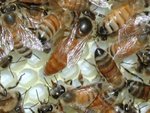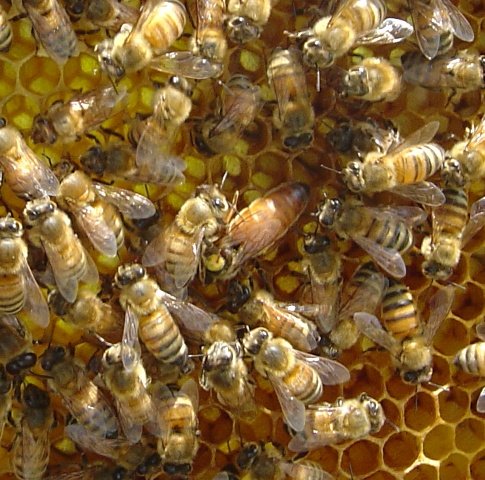.
 .
.Grafted plastic cell cups which have been pressed into the cell bar prior to grafting. Each bar holds 15 plastic cups.
.
.
.
.
.
.
I took a frame of eggs and larva from my next best hive. The hive has proven to be strong, but the bees are average in temperament and not as gentle as the mother queen I had hoped to use.
.

Cell bars with attached grafted plastic cell cups place in the cell bar frame. The frame is upside down, and will hang opposite in the cell builder hive.
.
See the frame of larva in the background?
.
Grafting is an interesting process.
The best queens are raised from larva that is newly hatched so I wanted to graft the smallest larva on the frame. The frame I selected from had everything from capped brood to eggs. With my reading glasses on it was easy to compare the sizes of the larva to make sure the youngest larva was selected. I used warm moist towels to keep the grafts warm and to keep them from drying out prior to transferring them into the cell building hive. After about 10 failures I was able to transfer the larva into the plastic cell cups. Since I created the cell building hive on June 1st it now contains, a few emerging brood, no eggs, no larva, and of course no queen. The only larva in the hive will be the young larva I grafted. If the bees accept the grafts they will begin to build queen cells from them. In 36 hours I should be able to see the results of the grafts.
.

.
The cell bar frame inserted into the queen cell builder hive. This hive has no queen, larva, or eggs other than what has been added with the cell cups.
.
.
I am hoping I will have more control of the process with the grafted cells verses the miller frame method used in prior weeks. There will be no question about the age of the larva and the expected emergence date of the queens. With the miller frame. eggs and larva of various ages could have been used by the bees to rear queens. Since the bees select which lava to turn into queens, there is less control. With the grafting method, since I was the one to select the larva, there should only be, at the most, 24 hours difference in the age of the queen cells.
.

From left to right. 10 frame cell builder hive, 4 section mating nuc, 4 section mating nuc. You can see the sugar syrup feeders. Only one of the mating nuc sections is in use. It contains a queen cell from the miller frame use peviously
.
36 hours will tell.








No comments:
Post a Comment